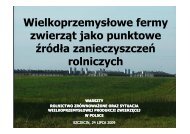best available technologies for manure treatment - Baltic Green Belt
best available technologies for manure treatment - Baltic Green Belt
best available technologies for manure treatment - Baltic Green Belt
You also want an ePaper? Increase the reach of your titles
YUMPU automatically turns print PDFs into web optimized ePapers that Google loves.
Best Available Technologies <strong>for</strong> <strong>manure</strong> <strong>treatment</strong> baltic sea 2020<br />
Best Available Technologies <strong>for</strong> <strong>manure</strong> <strong>treatment</strong> baltic sea 2020<br />
ANNEX E: TABLES WITH SHORT DESPRIPTION OF LIVESTOCK MANURE TREATMENT TECHNOLOGIES<br />
Best Available Techniques <strong>for</strong> <strong>manure</strong> <strong>treatment</strong> - <strong>for</strong> intensive rearing of pigs in <strong>Baltic</strong> Sea Region EU Member States Technical Report "Best Practice Manure Handling, Phase 2"<br />
Ref No. 43 Combustion of fibre fraction or solid <strong>manure</strong><br />
Brief description Description of the effect on leaching (positive or negative) of N and P<br />
Combustion can be made of separated fibre fractions, deep litter or<br />
other dry <strong>manure</strong> types.<br />
As a result of the high temperature all the odorous components are<br />
eliminated. The hot flue gases leaving the second chamber go through<br />
a heat exchanger, in which water is heated.<br />
The benefit of this technique is the production of an ash that can be<br />
used as a fertiliser and of hot water which is used <strong>for</strong> heating and<br />
which there<strong>for</strong>e saves fossil fuel use.<br />
Technically combustion works unproblematic, and can be fully<br />
automated, but fibres from slurry should according to the EU Waste<br />
Incineration Directive (2000/76/EF) be treated as waste, resulting in<br />
regulations of the smoke from combustion. This requires detailed<br />
measurements not applicable <strong>for</strong> farm scale use. The result is that<br />
fibres in practice should be incinerated in large waste combustion or<br />
CHP plants in combination with other biomasses such as straw, wood<br />
chips or household wastes.<br />
Innovation stage<br />
Investment price, <br />
Basic Variable<br />
Operational<br />
costs,<br />
per tonnes<br />
Most of the N will be converted to N<br />
2<br />
, and there<strong>for</strong>e not leach.<br />
Generally, combustion concentrates the P of the fibres or the solid <strong>manure</strong>, in the ash. The ash<br />
content of slurry fibres is relatively high (15-35%). The ash P is not well suited <strong>for</strong> plant uptake,<br />
but when treated with acid is can be made plant <strong>available</strong>. The ash should be reused <strong>for</strong> fertiliser<br />
production. In this case the resulting P-use could be better adapted to the crop needs.<br />
Combustion will loose the N content of the fibre fraction, some of it in the <strong>for</strong>m of NOx. These<br />
can, however, be cleaned off the smoke and thereby reducing the air pollution.<br />
However, often the ash is being used <strong>for</strong> other purposes, such as road fill, cement production,<br />
thereby reducing the risk of P leaching, but also loosing potential fertiliser from the production<br />
cycle.<br />
In some countries there are specific requirements as to the measurements of the emitted smoke<br />
increasing the cost of this technology. In addition, in Denmark there is a ‘waste-tax’ on fibres <strong>for</strong><br />
combustion.<br />
Economically it is doubtful at present in some countries and not presently being used in target<br />
countries.<br />
per kg saved N or P leaching Complexity of implementation<br />
Research<br />
Pilot <br />
Practice <br />
Major references<br />
Jørgensen et al.,<br />
2008<br />
Not relevant at farm scale as<br />
it should be delivered to<br />
large existing combustion<br />
plants<br />
Condition <strong>for</strong> leaching<br />
reduction effect<br />
Scenarios II to V.<br />
-<br />
Not relevant to<br />
calculate<br />
separately<br />
Certainty of in<strong>for</strong>mation<br />
Prices ?<br />
Effect on leaching High<br />
Cannot be calculated at present. Economic<br />
feasibility studies should be made in all<br />
target countries. Potentially a rather<br />
expensive technology.<br />
Easy to implement technically, with<br />
legislative challenges in relation to the<br />
interpretation of the EU Waste Incineration<br />
Directive<br />
67<br />
Page 69<br />
67








